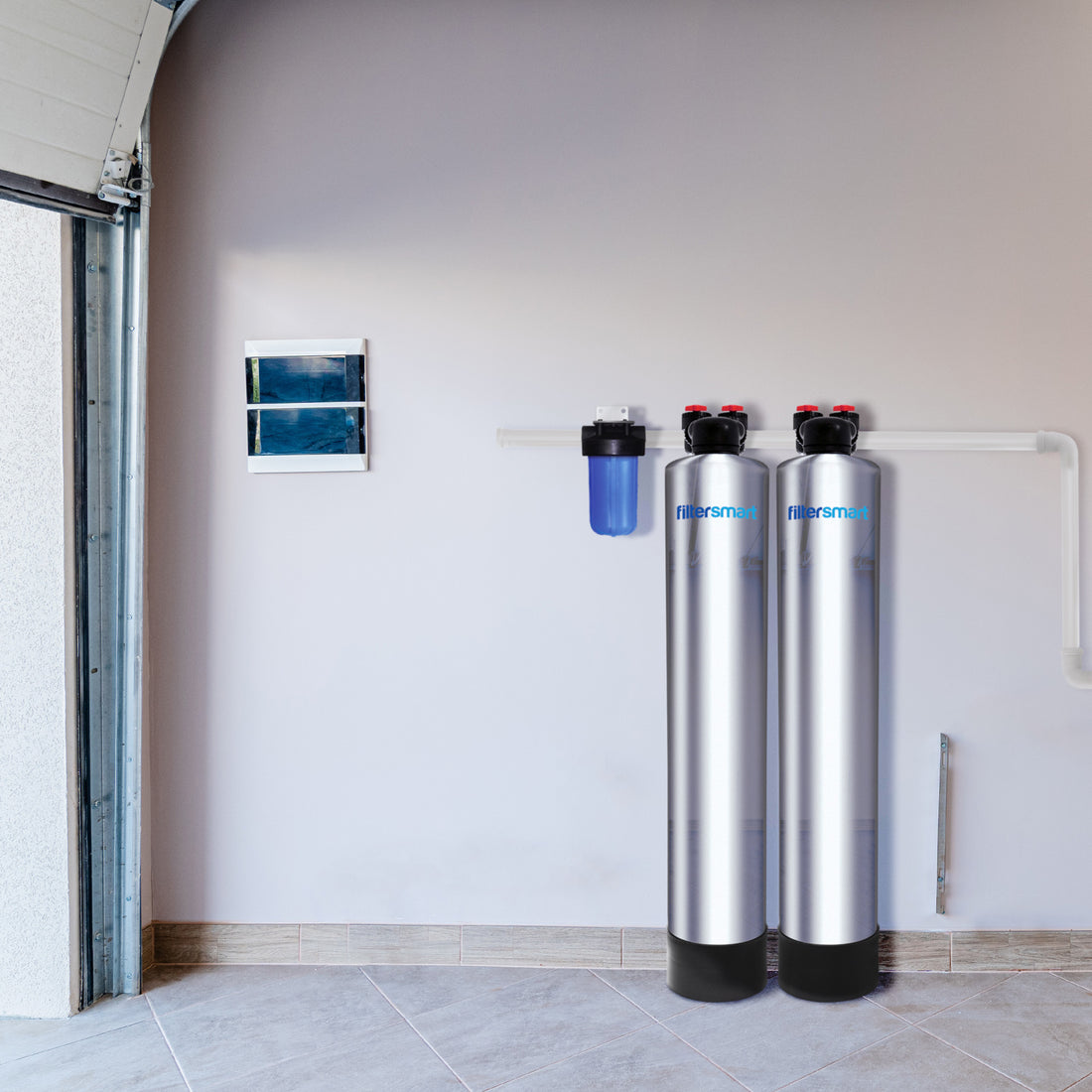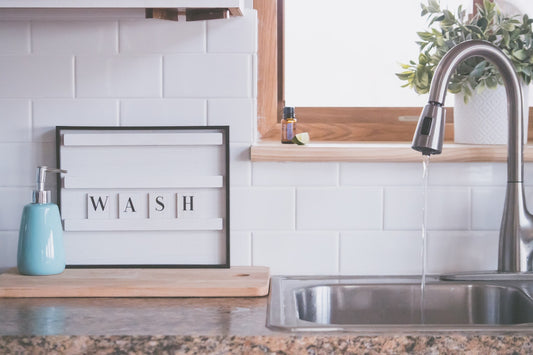Water softeners generally cost anywhere from $300 to $4000, depending on the type and quality of the water softener as well as installation costs. Some water softeners, though, like those that rely on salt or potassium, have significant recurring costs that could add up over time.
In the end, though, how much you spend on a water softener depends on the severity of the hardness. Check out this map to see if your area is likely to have a severe hard water problem. Also, keep in mind that your particular municipality might have a hard water problem even though the greater geographic area is largely unaffected. When in doubt, have a test done to see if you have hard water. Alternatively, check out this article to see if your house has the typical problems associated with limescale build-up.
In this article, we’re going to look at the cheapest options available for the average consumer and evaluate their efficacy, we’re going to examine the biggest and most easily changed factor in the overall cost of a water softener and show you how we can cut back on it, and we’re going to look at some theoretical costs for a salt or potassium-based ion exchange system and a salt-free water softener system.

Unit Size and System of Water Softener
There is no denying that the size and unit type are two major components that influence the initial cost of water softener. If you have a big home, your water usage requirement will be high. Put simply, you need larger amount of water for a bigger home that also requires water softener with higher efficiency.
Smaller homes, on the other hand, have lower water consumption and require a smaller water softener. Thus, it naturally saves cost.
It is worth mentioning that the capacity (amount of water a softener can soften) is a vital characterizing component of a unit. Typically, you can measure the capacity in grains (GPG). The GPG level you require depends on the degree of hardness of water in your home.
It also depends on the number of people using water in the household. It is always better to determine the hardness level of water using a home testing kit before buying a water softener.
The grain capacity of many water softeners is 20,000 to 80,000 on the market. A small household that has 2 to 3 people and three bathrooms needs a midsize softener with 20,000-grain capacity.
A larger house of five to six people may need a 32,000-grain capacity water softener. The larger the family and the larger, grain capacity it will require. However, there is no doubt that when you need the larger grain capacity, you have to invest in a hefty softener to meet the requirement.
Lowest Water Softener Prices (But Not the Best): Magnetic Water Softeners
Let’s say you’re looking for the cheapest water softener you can find. Maybe you don’t own the place you’re staying and you just want to find a way to temporarily alleviate all of your hard water problems. You could look into renting a water softener system, or you could look into buying the cheapest water softener you can find, just so you can get rid of your dry skin problems.
In that case, you’re probably going to stumble on a magnetic water softener that costs anywhere from $300-$600. Unfortunately, however, a magnetic water softener is unlikely to solve any of your hard water problems. There’s very little evidence that they’re effective, and when they are effective, the resulting limescale prevention is unfortunately pretty negligible. You could roll the dice and buy a magnetic water softener anyway, with the hope that it at least works a little bit, but you might be throwing your hard-earned money away.
Average Installation Costs
Next, after exhausting the cheapest magnetic water softeners and finding out that the research doesn’t necessarily back up their effectiveness, let’s look into some other systems. One of the most popular types of water softeners on the market today is salt-based ion exchange systems and reverse osmosis systems.
The water softener itself might not cost all that much, but a huge part of the overall cost is in installation. Some water softeners are going to require a professional installation by a specialist, while others are simple enough to do it yourself.
Typically, according to Fixr, the average installation cost for various systems looks like this:
-
$400 for an ion exchange salt-based system
-
$600 for a dual-tank system
-
$1000 for a high-end dual-tank system
So, not only do you have to factor in the cost of the system itself, you might even need to add anywhere from $400 to $1000 for installation.
On the other hand, a no-salt system like our FS1000 doesn’t require anywhere near the professional installation costs as the other systems. It’s simple enough to either do it yourself or hire a local plumber.
By the nature of how they function, ion exchange systems require a discharge pipe and a source for electricity. Otherwise, there will be no way to regenerate the system (and it will therefore be ineffective).
That’s why, if you’d like to cut back on installation costs, look for a salt-free water softener system.

Maintenance Costs for Various Systems
No matter which system you buy, ion exchange or template-assisted crystallization, there’s going to be some sort of maintenance cost. The costs associated with ion exchange, though, are much more severe than any other system.
Maintenance Costs for Ion Exchange
With an ion exchange system, you’re going to have to buy either a bag of salt or potassium in order for proper regeneration to take place (and in order for your system to continue working). A bag of salt every month is going to run you anywhere from $7-12. Not too bad, of course, but enough to add up. If you’d like to avoid the health consequences of increased sodium consumption, you could buy a bag of potassium every month, which will probably run you anywhere from $20-25.
Furthermore, you’re going to have to change out the resin once it expires, as well. Luckily, this only occurs once every five years or so.
Wastewater with Ion Exchange
Finally, you’ll have to factor in the waste water with ion exchange systems. How often you’ll have to regenerate your system depends on the hardness of your water. Here’s a good resource to determine how much water you’ll use for various makes and models of ion exchange water softeners. If you have any questions about how often you need to regenerate your system, call the manufacturer and ask them. Based on the hardness of your water, they should be able to give you a good answer.
According to the US Geological Survey, the average person uses about 80-100 gallons of water per day. Let’s go with the medium-range and say that you have a softener that’s rated at 34,000 grains and an average water hardness level of roughly 10 grains per gallon. If you have a three-person household, it’s safe to say you’re using roughly 300 gallons per day. At 10 grains per gallon, that means your water softener regenerates once every ten or eleven days. Then, another 100 gallons on average will be used for regeneration. Over the course of a year, that’s about ~3,650 gallons of waste water per year.
For comparison, that means you’re wasting about eight hot tubs of water per year. The cost might not be all that great, but the environmental footprint is certainly much worse than it has to be.
Maintenance Costs for Template-Assisted Crystallization
In a template-assisted crystallization system, on the other hand, you’re only going to have to replace the filter media once every one to three years, depending on how often they’re used. Compared to ion exchange, TAC systems are truly “set-it-and-forget-it.” They require nowhere near the same maintenance.
There’s no discharge. There’s no electricity. They’re much better for the environment while significantly reducing limescale production.
MORE>> Difference between a water filter vs a water softener
Theoretical Costs for a Mid-Range Ion Exchange System Versus a Salt-Free Template-Assisted Crystallization System
So, to wrap it up, let’s compare the theoretical costs for both a mid-range ion exchange system and a salt-free template-assisted crystallization system like the FilterSmart.
Mid-Range Ion Exchange System
Average ion exchange system cost: $700
Installation cost: $400
Monthly bag of salt: $10 (monthly bag of potassium: $25)
Resin replacement: ~$110
Total cost for one year of water softening: $1440 (and an extra $110 every five years or so).
Total cost for one year of water softening without salt: $1720
Mid-Range Template-Assisted Crystallization System
FilterSmart’s FS1000 system cost: $687.
Installation cost: $200 (for plumber or DIY).
Carbon replacement: $150 for high-grade Jacobi Carbon once every one to three years.
Total cost for one year of water softening: $887 (and an extra $150 every one to three years, depending on use).
How Long Does a Water Softener Last?
Estimating a single figure is little difficult here as there are several factors that contribute to durability of a water softener. However, when you buy a premium quality water softener like ours, you get what you invest for.
When you go for budget options on the market, they may come with higher maintenance cost and a shorter durability. In general, a higher to medium quality unit may last to ten to fifteen years, and even longer.
As long as you take care of your water softener, it will work efficiently for years.
Water Softener Cost Conclusion
There are a lot of hidden costs when it comes to buying a water softener. For one, if you’re looking for the cheapest option available, you’re probably going to want to go with a magnetic water softener. However, the problem with magnetic water treatment is the lack of scientific evidence proving its efficacy. There are probably some effective magnetic water softeners on the market, but it’s going to be difficult to separate the legitimate systems from the snake oil.
When it comes to buying an ion exchange water softener, you’re going to be accumulating a lot of maintenance costs (as well as installation). Since the plumber will need to install a discharge line and find an electricity source, it’s going to be significantly more difficult and significantly more expensive. Unless you’re highly experienced with plumbing, it’s not a job you want to do on your own. Beyond that, you’re going to have to pay for monthly salt or potassium replacements, which can add up to anywhere from $120 to $300 a year.
Your best bet, if you’re looking for a great value, is to go with a high-quality template-assisted crystallization system like those that we sell at FilterSmart. It’s truly set-it-and-forget-it. As a result, your annual costs for water softening will equal roughly half of what you would have to pay for an ion exchange system. You also won’t be generating eight hot tubs full of wastewater per year, which is just icing on the cake.
More>> Shop Whole House Water Filter
Questions? Concerns? Feel free to get in touch:
Call us: 866.455.9989
Email us: sales@filtersmart.com
FAQs
· How much does a water softener cost you per year?
After installation cost, you can expect to shell out around 20 to 40 cents for an ion-exchange water softener per day. But it is only the running cost and doesn’t include the price of sodium. You have to pay more for sodium if you dual-tank water softener.
· How can I find out the size of water softener I need to purchase?
You can easily determine the unit sizes of water softener you need by checking what way, and how often, your household uses water supply. You can measure water hardness of your home water in grains (GPG). Water supply measures the level of water hardness in PPM (parts per million). One GPG is typically equal to 16.1 PPM.
Find the maximum level of GPG of water hardness and multiply the total number of members in your home with the gallons of water they use daily. Total up the gallons per member figures. Multiply it by the number of grains water in your home contains. It will give you a final figure.






